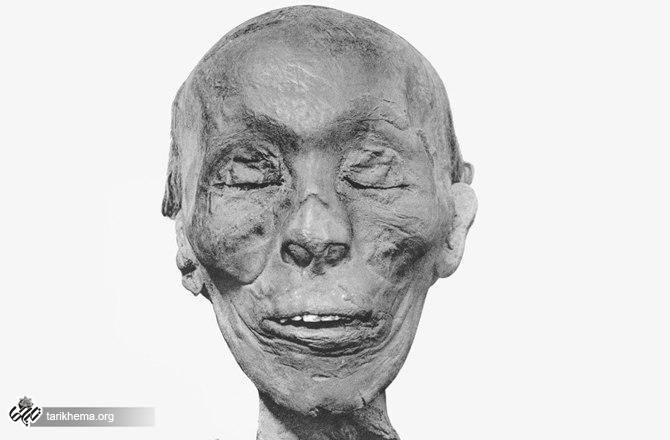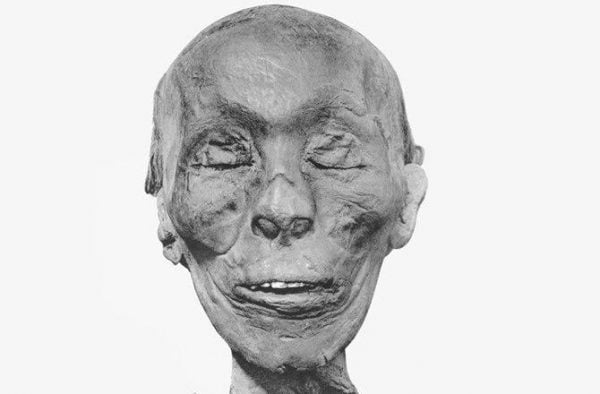شناسایی مومیای ها هنوز علمی نامشخص است

شناسایی مومیای ها هنوز علمی نامشخص است
شاه تات یکی ازمعدود مومیایی هایی است که به درستس شناسایی شده است
شاه توت عنخ آمون یکی از پادشاهان هجدهمین سلسله فراعنه است که مومیایی اش (طبق تحقیقات جدیدی که در رابطه با مومیایی های سلطنتی مصر قدیم انجام گرفته)با اطمینان شناسایی شده است.اجداد شاه توت ،یویا و تویا هم بدون شک شناسایی شده اند ؛این درحالی است که نظرات متفاوتی درباره شناسایی دیگر مومیایی ها وجود دارد.محققان روش ها و موانعی که در گذشته برای نامگذاری مومیایی ها ی مشهور هجدهمین سلسله استفاده می شد را در کتاب سالانه انسان شناسی فیزیکی بررسی و منتشر کردند که شامل پادشاهانی مانند آمنهوتپ سوم ، آخناتون ، نفرتیتی و توت عنخ آمون می شود.
مومیایی های مرموز: آنها چه کسانی هستند
تجزیه و تحلیل متا تمام روش های استفاده شده در هویت مومیایی ها را بررسی می کند . این روش ها بررسی انسان شناسی ، ژنتیک، شباهت صورت، کتیبه های تاریخی، و نام های برچسب شده در باند های مومیایی را شامل می شود.(طبق گفته فرانک روهلی (مدیر موسسه تکاملی پزشکی در دانشگاه زوریخ) به اخبار اکتشافات ، در کل فقط درباره شناسایی مومیایی توت عنخ آمون و اجدادش یویا و تویا هم نظری وجود دارد.این نتایج نشان دهنده مشکلات موجود در رابطه با شناسایی مومیایی های سلطنتی می باشد.روهلی و همکارش مایکل هابیچت و ابیگیل بومن تحقیقاتشان را روی خاندان توتموسیس (از توتموسیس دوم تا توت عنخ آمون)متمرکز کرده اند.
صورت و مدل مو مومیایی ها به صورت سه بعدی اشکار شد
بعضی از مومیایی هایی که اخیرا با استفاده از ژنتیک ملکولی ،در پروژه خاندان توت عنخ آمون مورد بررسی قرار گرفته است توسط تیمی که زاهی هاواس(مدیر سابق آثار باستانی مصر) استخدام کرده است انجام می شود.دانشمندان ۱۱ مومیایی سلطنتی را که احتمال می دادند با شاه توت مرتبط باشند مورد بررسی قرار دادند در حالی که ۵ مومیایی دیگر که از لحلظ تاریخی به اوایل پادشاهی جدید ارتباط داده شده بودند(۴۷۹ تا ۱۵۵۰ قبل از میلاد مسیح) به عنوان گروه شاهد انتخاب شدند.برای ایجاد اثر انگشت ژنتیکی هر مومیایی محققان( به رهبری هاواس) از ۸ دسته از نشانگر ها ی ژنتیکی استفاده کردند.نشانگر های مشترک کمک می کند تا پنج نسل از اجداد بعد از تات عنح آمون را نشان بدهیم.
نشانه های زنای با محارم در مومیایی های مشهور
یویا و تویا به عنوان اجداد شاه توت شناخته شدند و آمنهوتپ سوم و مومیایی KV35EL که متعلق به یک بانوی سالمند بوده است به عنوان پدر بزرگ و مادر بزرگش شناخته شدند. در حالی که اسکلت k755( که به احتمال بیشتر آخناتون است)و باK735YL (یعنی همان بانوی جوان) خواهر و برادر و همچنین والدین شاه تات هستند. روهلی گفت تحقیقات ما به صور اساسی از نتایج DNA پیروی می کند.محققان همچنین اشاره کرده که تست ژنتیک برای ادعای نسب در دادگاه های انگلیس و آمریکا هم کافی نیست.
توهم نوری:مومیایی کودکی که چشمش را باز و بسته می کند
در دادگاه انگلستان حداقل ۱۰ مدرک و در امریکا حداقل ۱۳ مدرک برای اثبات رابطه نسبی لازم است .پروژه خانواده تات عنخ آمون تنها ۸ مدرک دارد.روهلی می گوید: “البته باید متذکر شد که کاربرد ابزار ژنتیکی با تحلیل DNA های یک مومیایی ۳۵۰۰ ساله کاملا متفاوت و البته چالش برانگیز است”.بعد از بررسی تمام راه های ممکن برای نامگذاری مومیایی روهلی و همکارانش هویت پیشنهادی خود را ارائه دادند.آنها با تست ژنتیک برای تعین هویت مومیایی توتموسیس دوم ،آمنحوتپ، یویا ، تویا ، ملکه تیجیه ، آخناتون و توت عنخ آمون هم نظر هستند.این نوع آزمایش ژنتیک با تحقیقات ژنتیکی بکارگرفته شده برای تعین هویت مومیایی CG61072 یا KV35YL (همان مومیایی بانوی جوان ) متفاوت است.
برای اولین بار کلیه ای در بدن مومیایی کشف شد
درحالی که بدن مومیایی طبق تست DNA بدون هویت باقی مانده بود روهلی و همکارانش آن را به ملکه نفرتیتی نسبت دادند.او همچنین اضافه کرد:”اگر چه به طور کامل در این رابطه نمی توان مطمئن بود اما شواهد موجود در کتیبه هاو شباهت صورت با توت عنخ آمون که در سی تی اسکن مشخص شده تا حد زیادی این اطمینان را می دهد که این مومیایی متعلق به نفرتیتی می باشد.نام نفرتیتی در کتیبه ای به نام مادر توت عنخ آمون برده شده و قطعا این مومیایی که به عنوان بانوی جوان شناخته می شود از نظر ژنتیکی مادر شاه توت است.”
مومیایی های مصر باستان با جواهراتی که استفاده می کردند کشف شدند
اگر این تعین هویت درست بوده باشد پس این نظریه که نفرتیتی در سرداب پشت دیوار غربی مقبره شاه توت ساکن بوده به طور خودکار رد می شود.در این مطالعه ،موارد انتخابی از دیگر مومیایی های کمیاب هجدهمین سلسله می باشند مانند فرعون مرموزاسمنخکارع ، ملکه کیا، همسر ثانویه و مرموز آخناتون ، و ملکه مریتاتون یعنی همان دختر بزرگ آخناتون و نفرتیتی که به جای برادر صغیرش توت عنخ آمون نایت السلطنه شد.محققان می گویند :”البته این امکان وجود دارد که دیگر هیچ مومیایی و شی قدیمی پیدا نشود .
.”
Mummy Identification Still Uncertain Science
Feb 8, 2016 07:30 AM ET // by Rossella Lorenzi
Top of Form
Bottom of Form
View Related Gallery »
The King Tut mummies is one of the few to be positively identified.
Harry Burton/Wikimedia Commons
King Tutankhamun is the only 18th Dynasty pharaoh whose mummy has been identified with certainty, says a new study into some of the most famous ancient Egyptian royal mummies.
King Tut’s great-grandparents, Yuya and Thuya, have also been identified beyond doubt, while different opinions appear to circulate about the identity of almost all the other mummies.
Published in the Yearbook of Physical Anthropology, the research reviews methods and pitfalls used to name the mummies of the famous 18th Dynasty, which includes royals such as Amenhotep III, Akhenaton, Nefertiti and Tutankhamun.
Photos: Mystery Mummies: Who Are They?
The meta-analysis examines all the procedures used to identify these mummies, such as anthropological examination, genetics, facial resemblance, historic inscriptions, and name tags found directly on the bandages.
“Overall, agreement emerges only for the identities of Tutankhamun and his great-grandparents Yuya and Thuya. Such results demonstrate the difficulties in identifying ancient Egyptian royal mummies,” Frank Rühli, director of the Institute of Evolutionary Medicine at the University of Zurich, told Discovery News.
Rühli and colleagues Michael Habicht and Abigail Bouwman focused their investigation on the mummies of the so-called Thutmoside dynasty, from Thutmosis II to Tutankhamun.
Photos: Mummies’ Faces, Hairdos, Revealed in 3D
Some of these mummies have been recently investigated using molecular genetics in the so-called “Tutankhamun Family project,” carried out by a team recruited by Zahi Hawass, Egypt’s former head of antiquities.
The scientists tested 11 royal mummies suspected of being related to King Tut, while five other royal individuals dating to the early New Kingdom (1550-1479 B.C.) were chosen as a control group.
To create a genetic fingerprint for each mummy, the researchers led by Hawass used eight sets of genetic markers. Shared markers helped produce a five-generation pedigree of Tutankhamun’s immediate lineage.
Photos: Signs of Incest in Famous Mummies
Yuya and Thuya were recognized as King Tut’s great-grandparents. Pharaoh Amenhotep III and the mummy known as the Elder Lady (KV35EL) were found to be his grandparents, while the skeleton known as KV55 — most likely Akhenaton — and KV35YL, the Younger Lady, were identified as siblings, as well as King Tut’s parents.
“Our review basically supports the DNA results,” Rühli said.
The researchers noted however that the genetic tests would have not been enough in UK and US courts today to claim parentage.
Optical Illusion: Child Mummy Opens And Closes Her Eyes
In UK courts at least 10 matches are required, while in North America 13 matches are necessary to claim relationship. The Tutankhamun Family project gave 8 matches.
“It should be said that working with modern genetic material is one thing, analyzing some 3,500 year-old DNA a totally different one. Obviously, it is much more challenging,” Rühli said.
After reviewing all the possible methods used to name the mummies, Rühli and colleagues proposed their own identification.
They agreed with the genetic tests on the identifications of the mummies of Thutmosis II, Amenhotep III, Yuya, Thuya, Queen Tjye, Akhenaton and Tutankhamun.
The study differs from the genetic research for one identification, that of the mummy CG 61072 or KV35YL, the Younger Lady.
Kidney Spotted For First Time in Egyptian Mummy
While the body remains unidentified according to DNA tests, Rühli and colleagues present her as Queen Nefertiti.
“We can’t be fully certain of her identity, however inscriptional evidence and facial resemblance with Tutankhamun as seen in CT scans, strongly suggests the mummy belongs to Nefertiti,” Rühli said.
“Nefertiti is labelled in inscriptions to be Tutankhamun’s mother and indeed the mummy known as the Younger Lady is genetically suggested to be King Tut’s mother,” he added.
Ancient Egyptian Mummy Wearing Jewels Found
If the identification is correct, the theory that Nefertiti is the occupant of a secret crypt behind the western wall of King Tut’s tomb would be automatically ruled out.
In this case, candidates would be other elusive 18th Dynasty mummies, such as the enigmatic pharaoh Smenkhkare, Queen Kiya, the mysterious secondary wife of Akhenaton, and Queen Meritaton, the eldest daughter of Akhenaton and Nefertiti who might have acted as a regent for her underage brother Tutankhamun.
“But it is also possible that no mummy and artifacts at all will be found,” the researchers said.
منبع : ترجمه شده توسط سایت تاریخ ما

